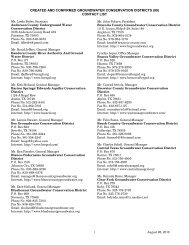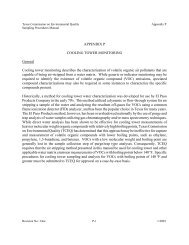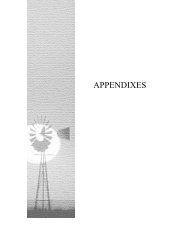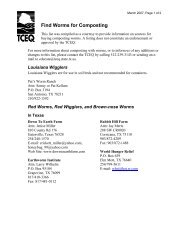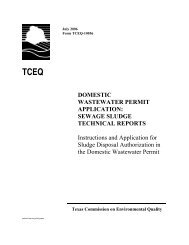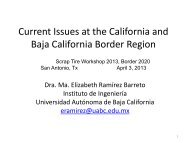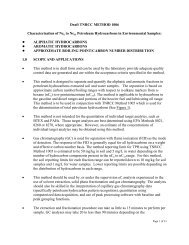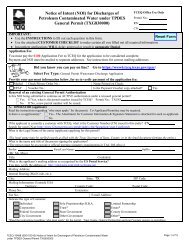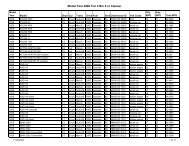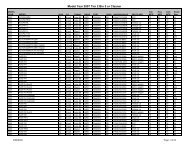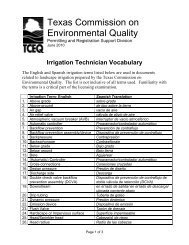Maps <str<strong>on</strong>g>of</str<strong>on</strong>g> envir<strong>on</strong>mental characteristics and other documents were collected from the state <str<strong>on</strong>g>of</str<strong>on</strong>g> <str<strong>on</strong>g>Texas</str<strong>on</strong>g>, U.S.EPA-Corvallis, USGS, and from other sources. The most important <str<strong>on</strong>g>of</str<strong>on</strong>g> these are listed in the Referencessecti<strong>on</strong>. The most useful map types for our ecoregi<strong>on</strong> delineati<strong>on</strong> generally include physiography or landsurface form, geology, soils, climate, vegetati<strong>on</strong>, and land cover/land use. There are several different smallscalephysiographic maps <str<strong>on</strong>g>of</str<strong>on</strong>g> <str<strong>on</strong>g>Texas</str<strong>on</strong>g> that can be found in a variety <str<strong>on</strong>g>of</str<strong>on</strong>g> publicati<strong>on</strong>s. Statewide physiographicand land surface-form descripti<strong>on</strong>s and maps were gathered from sources including the Bureau <str<strong>on</strong>g>of</str<strong>on</strong>g> Ec<strong>on</strong>omicGeology (<str<strong>on</strong>g>199</str<strong>on</strong>g>6), Raisz (1957), Bayer (1983), Hamm<strong>on</strong>d (1970), Hunt (1967, 1974) and Fenneman (1931,1938). Topography and land-form features were also discerned from 1:250,000, 1:100,000, and larger scaletopographic maps, and from a variety <str<strong>on</strong>g>of</str<strong>on</strong>g> digital elevati<strong>on</strong> models (e.g., Thelin and Pike <str<strong>on</strong>g>199</str<strong>on</strong>g>1). Geologicinformati<strong>on</strong> was gathered from maps such as the 1:500,000-scale state map (Barnes <str<strong>on</strong>g>199</str<strong>on</strong>g>2) and other state andregi<strong>on</strong>al maps (Kier et al., 1977; Renfro 1973); from surrounding state geology maps for New Mexico (Daneand Bachman 1965, New Mexico Bureau <str<strong>on</strong>g>of</str<strong>on</strong>g> Geology and Mineral Resources 2003), Louisiana (Snead andMcCulloh 1984), and Oklahoma; from the 1:1,000,000-scale Quaternary geology series (Moore et al., <str<strong>on</strong>g>199</str<strong>on</strong>g>3,Richm<strong>on</strong>d et al., <str<strong>on</strong>g>199</str<strong>on</strong>g>0, Richm<strong>on</strong>d and Christiansen <str<strong>on</strong>g>199</str<strong>on</strong>g>4, Fullert<strong>on</strong> et al., 2003); from state, regi<strong>on</strong>al, or localgeology descripti<strong>on</strong>s (e.g., Spearing <str<strong>on</strong>g>199</str<strong>on</strong>g>1, Ryder <str<strong>on</strong>g>199</str<strong>on</strong>g>6); and from nati<strong>on</strong>al scale maps such as Hunt (1979),Bayer (1983), and King and Biekman (1974).Soils informati<strong>on</strong> was obtained from the USDA county soil surveys, the 1:250,000-scale STATSGO soildata base (USDA NRCS <str<strong>on</strong>g>199</str<strong>on</strong>g>4), and state and regi<strong>on</strong>al publicati<strong>on</strong>s (e.g., Godfrey et al., 1973). Because soiltax<strong>on</strong>omy and interpretati<strong>on</strong>s are dynamic, and current soil series names may be different from those in earlierpublicati<strong>on</strong>s, soil informati<strong>on</strong> and ecological aggregati<strong>on</strong>s <str<strong>on</strong>g>of</str<strong>on</strong>g> STATSGO or other soil data were also obtainedfrom state soil experts (Micheal Golden, Susan Casby-Hort<strong>on</strong>, James Greenwade, USDA NRCS, pers<strong>on</strong>alcommunicati<strong>on</strong>s).Climate informati<strong>on</strong> and summaries were based <strong>on</strong> a variety <str<strong>on</strong>g>of</str<strong>on</strong>g> data and sources. These included 1971-2000 and 1961-<str<strong>on</strong>g>199</str<strong>on</strong>g>0 data summaries from the Southern Regi<strong>on</strong>al Climate Center (http://www.srcc.lsu.edu/) informati<strong>on</strong> from the <str<strong>on</strong>g>Texas</str<strong>on</strong>g> state climatologist (http://www.met.tamu.edu/met/osc/osc.html), fromprecipitati<strong>on</strong> and temperature informati<strong>on</strong> based <strong>on</strong> the PRISM model (Daly et al., <str<strong>on</strong>g>199</str<strong>on</strong>g>7; http://www.ocs.orst.edu/prism/prism_new.html), from state summaries (Larkin and Bomar 1983, Ort<strong>on</strong> 1974, Russell 1945),from data in Koss et al., (1988), and from climate informati<strong>on</strong> listed in the county soil surveys.Statewide vegetati<strong>on</strong> informati<strong>on</strong> for <str<strong>on</strong>g>Texas</str<strong>on</strong>g> includes that from sources such as McMahan et al., (1984),Bezans<strong>on</strong> (2000), Gould (1975), and Tharp (1939). Regi<strong>on</strong>al vegetati<strong>on</strong> informati<strong>on</strong> came from sources suchas Diggs et al., (<str<strong>on</strong>g>199</str<strong>on</strong>g>9), NatureServe (2002), and Brown (<str<strong>on</strong>g>199</str<strong>on</strong>g>4). Vegetati<strong>on</strong> and forest type informati<strong>on</strong> werealso obtained from Braun (1950), Kuchler (1964), the forest atlas <str<strong>on</strong>g>of</str<strong>on</strong>g> the South (USDA, Forest Service 1969),the nati<strong>on</strong>al atlas (Kuchler 1970; U.S. Forest Service 1970), USDA Forest Service (<str<strong>on</strong>g>199</str<strong>on</strong>g>7), from numerousjournal manuscripts listed in the references, from in-state pers<strong>on</strong>nel with botanical expertise (e.g., StevenHatch, <str<strong>on</strong>g>Texas</str<strong>on</strong>g> A&M; David Bezans<strong>on</strong>, Natural Area Preservati<strong>on</strong> Associati<strong>on</strong>; Raym<strong>on</strong>d Telfair (TPWD,Retired) pers<strong>on</strong>al communicati<strong>on</strong>s), and from web pages such as “A Checklist <str<strong>on</strong>g>of</str<strong>on</strong>g> the Vascular Plants <str<strong>on</strong>g>of</str<strong>on</strong>g><str<strong>on</strong>g>Texas</str<strong>on</strong>g>” (http://www.csdl.tamu.edu/FLORA/taes/tracy/regeco.html).For land use/land cover we used primarily the Nati<strong>on</strong>al Land Cover Data set (NLCD), part <str<strong>on</strong>g>of</str<strong>on</strong>g> the Multi-Resoluti<strong>on</strong> Land Characterizati<strong>on</strong> (MRLC) c<strong>on</strong>sortium activities. This data is based <strong>on</strong> early to mid-<str<strong>on</strong>g>199</str<strong>on</strong>g>0’sLandsat Thematic Mapper satellite data <str<strong>on</strong>g>of</str<strong>on</strong>g> 30 meter resoluti<strong>on</strong> (Vogelmann et al., 2001). We also used the1:250,000 scale land use/land cover maps from the U.S. Geological Survey (USGS 1986), and the generalland use classificati<strong>on</strong> <str<strong>on</strong>g>of</str<strong>on</strong>g> Anders<strong>on</strong> (1970). For assessing variati<strong>on</strong>s in the mix <str<strong>on</strong>g>of</str<strong>on</strong>g> agriculture activities as anexpressi<strong>on</strong> <str<strong>on</strong>g>of</str<strong>on</strong>g> land potential, maps from the 1987, <str<strong>on</strong>g>199</str<strong>on</strong>g>2 and <str<strong>on</strong>g>199</str<strong>on</strong>g>7 Census <str<strong>on</strong>g>of</str<strong>on</strong>g> Agriculture were analyzed (U.S.Department <str<strong>on</strong>g>of</str<strong>on</strong>g> Commerce <str<strong>on</strong>g>199</str<strong>on</strong>g>0, <str<strong>on</strong>g>199</str<strong>on</strong>g>5; U.S. Department <str<strong>on</strong>g>of</str<strong>on</strong>g> Agriculture N<str<strong>on</strong>g>AS</str<strong>on</strong>g>S <str<strong>on</strong>g>199</str<strong>on</strong>g>9). In additi<strong>on</strong>, a mapproduced from composited multi-temporal Advanced Very High Resoluti<strong>on</strong> Radiometer (AVHRR) satellitedata was also used to assess boundaries and regi<strong>on</strong>al differences. This AVHRR NDVI (Normalized DifferenceVegetati<strong>on</strong> Index) data is also used by the USGS Center for Earth Resources Observati<strong>on</strong> and Science (EROS)Data Center to characterize land cover <str<strong>on</strong>g>of</str<strong>on</strong>g> the c<strong>on</strong>terminous United States (Loveland et al., <str<strong>on</strong>g>199</str<strong>on</strong>g>1, <str<strong>on</strong>g>199</str<strong>on</strong>g>5).In additi<strong>on</strong> to the comp<strong>on</strong>ent informati<strong>on</strong> listed above, other existing ecological, biological, or physical<str<strong>on</strong>g>Ecoregi<strong>on</strong>s</str<strong>on</strong>g> <str<strong>on</strong>g>of</str<strong>on</strong>g> <str<strong>on</strong>g>Texas</str<strong>on</strong>g> 3
frameworks were examined. These include the <str<strong>on</strong>g>Texas</str<strong>on</strong>g> ecoregi<strong>on</strong>s <str<strong>on</strong>g>of</str<strong>on</strong>g> the LBJ School <str<strong>on</strong>g>of</str<strong>on</strong>g> Public Affairs (1978),<str<strong>on</strong>g>Texas</str<strong>on</strong>g> ecological areas shown by McMahan et al., (1984), Bezans<strong>on</strong> (2000), and Telfair (<str<strong>on</strong>g>199</str<strong>on</strong>g>9), the USFSsecti<strong>on</strong>s and subsecti<strong>on</strong>s (Keys et al., <str<strong>on</strong>g>199</str<strong>on</strong>g>5), ecoregi<strong>on</strong>s <str<strong>on</strong>g>of</str<strong>on</strong>g> the Nature C<strong>on</strong>servancy (The Nature C<strong>on</strong>servancyEcoregi<strong>on</strong>al Working Group <str<strong>on</strong>g>199</str<strong>on</strong>g>7, The Nature C<strong>on</strong>servancy 2003), Major Land Resource Areas (USDA SCS1981) and later derivatives developed by NRCS, and the natural land-use regi<strong>on</strong>s <str<strong>on</strong>g>of</str<strong>on</strong>g> Barnes and Marschner(1933), am<strong>on</strong>g others. Also <str<strong>on</strong>g>of</str<strong>on</strong>g> major importance in our process <str<strong>on</strong>g>of</str<strong>on</strong>g> regi<strong>on</strong>alizati<strong>on</strong> were the mental maps thatlocal experts brought to discussi<strong>on</strong> meetings, reviews, or field rec<strong>on</strong>naissance trips.We used USGS 1:250,000-scale topographic maps as the base for delineating and digitizing the ecoregi<strong>on</strong>boundaries. Although this map series is dated, it does provide quality in terms <str<strong>on</strong>g>of</str<strong>on</strong>g> the relative c<strong>on</strong>sistency andcomparability <str<strong>on</strong>g>of</str<strong>on</strong>g> the series, in the accuracy <str<strong>on</strong>g>of</str<strong>on</strong>g> the topographic informati<strong>on</strong> portrayed, and in the locati<strong>on</strong>alc<strong>on</strong>trol. It is also a very c<strong>on</strong>venient scale. Fifty <strong>on</strong>e <str<strong>on</strong>g>of</str<strong>on</strong>g> these maps give complete coverage <str<strong>on</strong>g>of</str<strong>on</strong>g> <str<strong>on</strong>g>Texas</str<strong>on</strong>g>.RESULTS AND REGIONAL DESCRIPTIONSWe have divided <str<strong>on</strong>g>Texas</str<strong>on</strong>g> into twelve level III ecoregi<strong>on</strong>s (Figure 1, p. v) and 56 level IV ecoregi<strong>on</strong>s(Figure 2, p. vi). Although these level IV ecoregi<strong>on</strong>s still c<strong>on</strong>tain some heterogeneity in factors that can affectwater quality and biotic characteristics, they provide a more detailed framework and more precise ecoregi<strong>on</strong>boundaries than the earlier nati<strong>on</strong>al-scale ecoregi<strong>on</strong>s (Omernik 1987). The ecoregi<strong>on</strong> framework also providesmore homogeneous units for inventorying, m<strong>on</strong>itoring, and assessing surface waters than the comm<strong>on</strong>ly usedhydrologic unit frameworks or political unit frameworks (Omernik and Bailey <str<strong>on</strong>g>199</str<strong>on</strong>g>7, Omernik and Griffith<str<strong>on</strong>g>199</str<strong>on</strong>g>1, Griffith et al., <str<strong>on</strong>g>199</str<strong>on</strong>g>9, Omernik 2003). Major river basins drain strikingly different ecological regi<strong>on</strong>s. Amap poster <str<strong>on</strong>g>of</str<strong>on</strong>g> the ecoregi<strong>on</strong>s <str<strong>on</strong>g>of</str<strong>on</strong>g> <str<strong>on</strong>g>Texas</str<strong>on</strong>g> has been published by USGS (Griffith et al., 2004).23 Ariz<strong>on</strong>a/New Mexico MountainsThe Ariz<strong>on</strong>a/New Mexico Mountains are distinguished from neighboring mountainous ecoregi<strong>on</strong>s bylower elevati<strong>on</strong>s and an associated vegetati<strong>on</strong> indicative <str<strong>on</strong>g>of</str<strong>on</strong>g> drier, warmer envir<strong>on</strong>ments, due in part to theregi<strong>on</strong>’s more southerly locati<strong>on</strong>. Chaparral is comm<strong>on</strong> at lower elevati<strong>on</strong>s; piny<strong>on</strong>-juniper, and oak woodlandsare found at lower and middle elevati<strong>on</strong>s; and the higher elevati<strong>on</strong>s are mostly covered with open to densep<strong>on</strong>derosa pine forests. Forests <str<strong>on</strong>g>of</str<strong>on</strong>g> spruce, fir, and Douglas-fir are comm<strong>on</strong> in the Southern Rockies (21) andthe Wasatch and Uinta Mountains (19), but they are found <strong>on</strong>ly in limited areas at the highest elevati<strong>on</strong>s in thisregi<strong>on</strong>. Only a small porti<strong>on</strong> <str<strong>on</strong>g>of</str<strong>on</strong>g> Ecoregi<strong>on</strong> 23 occurs in <str<strong>on</strong>g>Texas</str<strong>on</strong>g>. The Guadalupe Mountains <strong>on</strong> the <str<strong>on</strong>g>Texas</str<strong>on</strong>g>-NewMexico border comprise the southernmost peaks <str<strong>on</strong>g>of</str<strong>on</strong>g> the Ariz<strong>on</strong>a/New Mexico Mountains ecoregi<strong>on</strong>.23a Chihuahuan Desert SlopesThe Chihuahuan Desert Slopes <str<strong>on</strong>g>of</str<strong>on</strong>g> the Guadalupe Mountains in <str<strong>on</strong>g>Texas</str<strong>on</strong>g> form theleading edge <str<strong>on</strong>g>of</str<strong>on</strong>g> a giant uplifted Permian reef created from the accumulated remains <str<strong>on</strong>g>of</str<strong>on</strong>g>algae, sp<strong>on</strong>ges, and marine bivalves (Spearing <str<strong>on</strong>g>199</str<strong>on</strong>g>1). The white, 2000 foot high cliffface dominates the landscape <str<strong>on</strong>g>of</str<strong>on</strong>g> the northern Trans-Pecos regi<strong>on</strong> <str<strong>on</strong>g>of</str<strong>on</strong>g> <str<strong>on</strong>g>Texas</str<strong>on</strong>g>. The lowerslopes <str<strong>on</strong>g>of</str<strong>on</strong>g> the mountains, composed <str<strong>on</strong>g>of</str<strong>on</strong>g> eroded limest<strong>on</strong>e, shale, and sandst<strong>on</strong>e, representa c<strong>on</strong>tinuati<strong>on</strong> <str<strong>on</strong>g>of</str<strong>on</strong>g> the Chihuahuan Desert ecosystem; soils and vegetati<strong>on</strong> in much<str<strong>on</strong>g>of</str<strong>on</strong>g> Ecoregi<strong>on</strong> 23a are similar to those in the Low Mountains and Bajadas (24c) <str<strong>on</strong>g>of</str<strong>on</strong>g> the Chihuahuan Desertecoregi<strong>on</strong> (24). Water is scarce; the few streams that originate from springs at higher elevati<strong>on</strong>s do not persistbey<strong>on</strong>d the mouths <str<strong>on</strong>g>of</str<strong>on</strong>g> major cany<strong>on</strong>s.The lower elevati<strong>on</strong> boundary <str<strong>on</strong>g>of</str<strong>on</strong>g> the Chihuahuan Desert Slopes ecoregi<strong>on</strong> (23a) coincides with the base <str<strong>on</strong>g>of</str<strong>on</strong>g>the Guadalupe Mountains at about 4500 to 5000 feet. Climate, vegetati<strong>on</strong>, and soil do not differ significantly<strong>on</strong> either side <str<strong>on</strong>g>of</str<strong>on</strong>g> the mapped boundary, but the line marks a physiographic and geological transiti<strong>on</strong> to themountainous ecosystem with its cliffs and cany<strong>on</strong>s. The upper boundary <str<strong>on</strong>g>of</str<strong>on</strong>g> Ecoregi<strong>on</strong> 23a is very generalized;it indicates the passage <str<strong>on</strong>g>of</str<strong>on</strong>g> desert shrubs and grassland to woodland and surrounds the core <str<strong>on</strong>g>of</str<strong>on</strong>g> the forested area<str<strong>on</strong>g>of</str<strong>on</strong>g> the <str<strong>on</strong>g>Texas</str<strong>on</strong>g> Guadalupe Mountains. The scale <str<strong>on</strong>g>of</str<strong>on</strong>g> mapping is not detailed enough to represent strips <str<strong>on</strong>g>of</str<strong>on</strong>g> riparian4<str<strong>on</strong>g>Ecoregi<strong>on</strong>s</str<strong>on</strong>g> <str<strong>on</strong>g>of</str<strong>on</strong>g> <str<strong>on</strong>g>Texas</str<strong>on</strong>g>
- Page 1: Below is an Electronic Version <str
- Page 4 and 5: ECOREGIONS OF TEXAS</strong
- Page 6 and 7: TABLE OF CONTENTSABSTRACT..........
- Page 8 and 9: 2526272526272330293235332430323423
- Page 10 and 11: INTRODUCTIONSpatial frameworks are
- Page 14 and 15: vegetation or small areas o
- Page 16 and 17: the only chipmunk in Texas<
- Page 18 and 19: to the north. There is a high deman
- Page 20 and 21: taller, coarser tobosa grass (Pleur
- Page 22 and 23: the fractured rock. The Bof
- Page 24 and 25: hollows, moving upslope to create c
- Page 26 and 27: The headwater catfish (Ictalurus lu
- Page 28 and 29: streams. Two sand plains streams, C
- Page 30 and 31: Several caliche horizons (calcium c
- Page 32 and 33: winds (Spearing 199</strong
- Page 34 and 35: Geology is an important geographica
- Page 36 and 37: the villages of Pa
- Page 38 and 39: Area (sq. mi.) 5569PhysiographyFlat
- Page 40 and 41: Tableland topography of</st
- Page 42: y the Brazos and Colorado rivers ha
- Page 45 and 46: Level IV Ecoregion27i. Broken Red P
- Page 47 and 48: Post oaks (Quercus stellata) and bl
- Page 49 and 50: Level IV Ecoregion29c. Western Cros
- Page 51 and 52: than the limestone of</stro
- Page 53 and 54: underlying the sandstone. This has
- Page 55 and 56: Since settlement, many wildlife spe
- Page 57 and 58: (Pellaeae spp.), Nuttall’s stonec
- Page 59 and 60: Trinity-Edwards aquifer, discharges
- Page 61 and 62: Edwards Plateau to savanna-like con
- Page 63 and 64:
species list, prefers fast moving w
- Page 65 and 66:
Level IV Ecoregion31a. Northern Nue
- Page 67 and 68:
31c Texas-Tamaulip
- Page 69 and 70:
31d Rio Grande Floodplain and Terra
- Page 71 and 72:
62shrink when dry and swell when we
- Page 73 and 74:
32b Southern Blackland PrairieThe S
- Page 75 and 76:
33 EAST CENTRAL TE
- Page 77 and 78:
and need some patchy distubances an
- Page 79 and 80:
33d Northern Prairie OutliersThe sm
- Page 81 and 82:
Level IV Ecoregion33e. Bastrop Lost
- Page 83 and 84:
34a Northern Humid Gulf Coastal Pra
- Page 85 and 86:
34b Southern Subhumid Gulf Coastal
- Page 87 and 88:
occasional discontinuous drainage r
- Page 89 and 90:
oundary was the ability to match th
- Page 91 and 92:
Level IV Ecoregion34f. Lower Rio Gr
- Page 93 and 94:
live oak trees (Quercus virginiana)
- Page 95 and 96:
Shoal grass (Halodule wrightii) mea
- Page 97 and 98:
Upland oak-pine forest in Ecoregion
- Page 99 and 100:
35c Pleistocene Fluvial TerracesThe
- Page 101 and 102:
35f FlatwoodsMostly flat to gently
- Page 103 and 104:
pasture, although some woodland sti
- Page 105 and 106:
invariant definition of</st
- Page 107 and 108:
how many stream sites/watersheds ar
- Page 109 and 110:
commonly believed. Typically, about
- Page 111 and 112:
CONCLUSIONS AND RECOMMENDATIONSThis
- Page 113 and 114:
104Ecoregions <str
- Page 115 and 116:
Biggs, B.J.F., M.J. Duncan, I.G. Jo
- Page 117 and 118:
Diggs, G.M., Jr., and P.C. Schulze.
- Page 119 and 120:
Graves, J. 2002. Texas</str
- Page 121 and 122:
Hunt, C.B. 1967. Physiography <stro
- Page 123 and 124:
Maxwell, T.C. 1979. Avifauna <stron
- Page 125 and 126:
Richmond, G.M., D.L. Weide, and D.W
- Page 127 and 128:
U.S. Department of
- Page 129 and 130:
Woods, A.J., J.M. Omernik, D.R. But
- Page 131 and 132:
Herbaceous Plants(Forbs, Grasses, a
- Page 133 and 134:
Hickory, BlackHickory, WaterHollyHu



